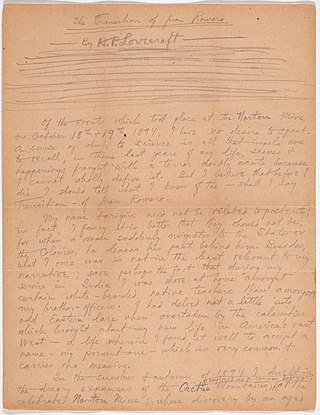
"The Call of Cthulhu" is a short story by American writer H. P. Lovecraft. Written in the summer of 1926, it was first published in the pulp magazine Weird Tales in February 1928.
"Supernatural Horror in Literature" is a 28,000-word essay by American writer H. P. Lovecraft, surveying the development and achievements of horror fiction as the field stood in the 1920s and 30s. The essay was researched and written between November 1925 and May 1927, first published in August 1927, and then revised and expanded during 1933–1934.

"The Outsider" is a short story by American horror writer H. P. Lovecraft. Written between March and August 1921, it was first published in Weird Tales, April 1926. In this work, a mysterious individual who has been living alone in a castle for as long as he can remember decides to break free in search of human contact and light. "The Outsider" is one of Lovecraft's most commonly reprinted works and is also one of the most popular stories ever to be published in Weird Tales.
Gallomo was the name of a circle of literary correspondence between Alfred Galpin, H. P. Lovecraft, and Maurice W. Moe in the first few decades of the 20th century. The name is derived from the first syllable of each author's last name. Lovecraft often used the group to workshop stories which he was working on, such as "The Statement of Randolph Carter". The other two members went on to publish stories in magazines such as The Vagrant, The Californian, or All-Story Magazine.

"Hypnos" is a short story by American horror fiction writer H. P. Lovecraft, penned in March 1922 and first published in the May 1923 issue of National Amateur.

Edgar Hoffmann Trooper Price was an American writer of popular fiction for the pulp magazine marketplace. He collaborated with H. P. Lovecraft on "Through the Gates of the Silver Key".

"Azathoth" is the beginning of an incomplete novel written by American horror fiction writer H. P. Lovecraft. It was written in June 1922, and published as a fragment in the journal Leaves in 1938, after Lovecraft's death. It is the first piece of fiction to mention the fictional being Azathoth, one of the major entities in Lovecraft's Cthulhu Mythos, though the entity only appears in the title.

"The Other Gods" is a fantasy short story written by American author H. P. Lovecraft, on August 14, 1921. It was first published in the November 1933 issue of The Fantasy Fan.

"The Descendant" is a horror story fragment by American writer H. P. Lovecraft, believed to have been written in 1927. It was first published in the journal Leaves in 1938, after Lovecraft's death.
"The Evil Clergyman" is an excerpt from a letter written by American horror fiction writer H. P. Lovecraft in 1933. After his death, it was published in the April 1939 issue of Weird Tales as a short story. The story was later adapted into the unreleased 1987 anthology film Pulse Pounders.

"The Moon-Bog" is a short story by American horror fiction writer H. P. Lovecraft, written in or before March 1921. The story was first published in the June 1926 issue of the pulp magazine Weird Tales.
"Ibid" is a parody by American horror fiction writer H. P. Lovecraft, written in 1927 or 1928, and first published in the January 1938, issue of O-Wash-Ta-Nong.
"A Reminiscence of Dr. Samuel Johnson" is a short story written in 1917 by American horror fiction writer H. P. Lovecraft. It was first published in the September 1917 issue of the United Amateur, under the pseudonym Humphrey Littlewit, Esq.

"The Transition of Juan Romero" is a short story by American horror fiction writer H. P. Lovecraft, written on September 16, 1919, and first published in the 1944 Arkham House volume Marginalia.
"The Very Old Folk" is the name given by publishers to a story found in the letter sent to Donald Wandrei by American horror fiction writer H. P. Lovecraft on 3 November 1927. Author Frank Belknap Long read this dream too, and asked Lovecraft permission to include it in a piece of his own fiction, which Lovecraft approved, and it is part of the novella "The Horror from the Hills".
Robert Hayward Barlow was an American author, avant-garde poet, anthropologist and historian of early Mexico, and expert in the Nahuatl language. He was a correspondent and friend of horror writer H. P. Lovecraft, who appointed Barlow as the executor of his literary estate.
"Till A' the Seas" is a post-apocalyptic short story by American horror fiction writer H. P. Lovecraft and R. H. Barlow. The title is a reference to the poem "A Red, Red Rose" by Robert Burns.
"The Book" is an unfinished short story by American horror fiction writer H. P. Lovecraft, believed to have been written in late 1933. It was first published in the journal Leaves in 1938, after Lovecraft's death.

Joseph Vernon Shea (1912–1981) was an American writer of horror, fantasy, poetry, and essays; and a correspondent of H. P. Lovecraft, Clark Ashton Smith, and August Derleth.
Alfred Galpin (1901–1983) was an American literary academic and musical composer of classical works. He is now best known as a close friend and correspondent of writer H. P. Lovecraft.









